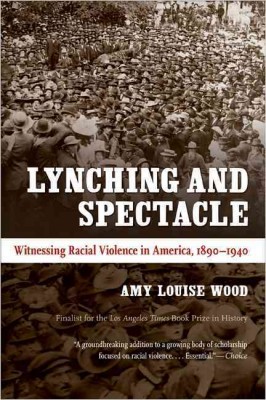| Lynching and Spectacle: Witnessing Racial Violence in America, 1890-1940 Contributor(s): Wood, Amy Louise (Author) |
|
 |
ISBN: 0807871974 ISBN-13: 9780807871973 Publisher: University of North Carolina Press OUR PRICE: $35.63 Product Type: Paperback - Other Formats Published: February 2011 |
| Additional Information |
| BISAC Categories: - History | United States - State & Local - South (al,ar,fl,ga,ky,la,ms,nc,sc,tn,va,wv) - Social Science | Violence In Society - History | Social History |
| Dewey: 364.134 |
| LCCN: 2008045194 |
| Series: New Directions in Southern Studies (Paperback) |
| Physical Information: 0.9" H x 6.1" W x 9.2" (1.20 lbs) 368 pages |
| Themes: - Ethnic Orientation - African American - Topical - Black History - Chronological Period - 1851-1899 - Chronological Period - 1900-1949 - Cultural Region - South |
| Descriptions, Reviews, Etc. |
| Publisher Description: Lynch mobs in late nineteenth- and early twentieth-century America exacted horrifying public torture and mutilation on their victims. In Lynching and Spectacle, Amy Wood explains what it meant for white Americans to perform and witness these sadistic spectacles and how lynching played a role in establishing and affirming white supremacy. Lynching, Wood argues, overlapped with a variety of cultural practices and performances, both traditional and modern, including public executions, religious rituals, photography, and cinema, all which encouraged the horrific violence and gave it social acceptability. However, she also shows how the national dissemination of lynching images ultimately fueled the momentum of the antilynching movement and the decline of the practice. Using a wide range of sources, including photos, newspaper reports, pro- and antilynching pamphlets, early films, and local city and church records, Wood reconfigures our understanding of lynching's relationship to modern life. Wood expounds on the critical role lynching spectacles played in establishing and affirming white supremacy at the turn of the century, particularly in towns and cities experiencing great social instability and change. She also shows how the national dissemination of lynching images fueled the momentum of the antilynching movement and ultimately led to the decline of lynching. By examining lynching spectacles alongside both traditional and modern practices and within both local and national contexts, Wood reconfigures our understanding of lynching's relationship to modern life. |
Contributor Bio(s): Wood, Amy Louise: - Amy Louise Wood is associate professor of history at Illinois State University. |